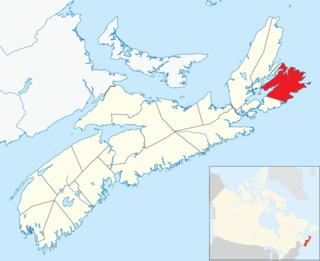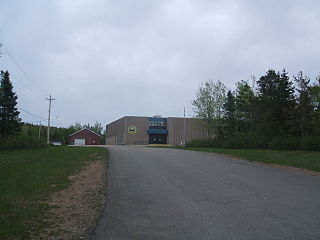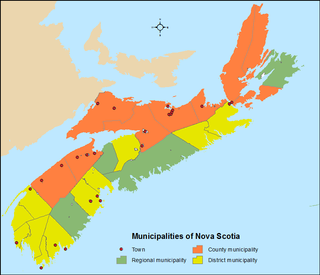
Cape Breton University (CBU) is a public, co-ed, primarily undergraduate university located in Sydney, Nova Scotia, Canada. It is the only post-secondary degree-granting institution within the Cape Breton Regional Municipality and on Cape Breton Island. The university is enabled by the Cape Breton University Act passed by the Nova Scotia House of Assembly. Prior to this, CBU was enabled by the University College of Cape Breton Act (amended). The University College of Cape Breton's Coat of Arms were registered with the Canadian Heraldic Authority on May 27, 1995.

Sydney is a former city and urban community on the east coast of Cape Breton Island in Nova Scotia, Canada within the Cape Breton Regional Municipality. Sydney was founded in 1785 by the British, was incorporated as a city in 1904, and dissolved on 1 August 1995, when it was amalgamated into the regional municipality.

Cape Breton County is one of eighteen counties in the Canadian province of Nova Scotia. It is located on Cape Breton Island.

Cape Breton Regional Municipality is the Canadian province of Nova Scotia's second largest municipality and the economic heart of Cape Breton Island. As of 2016 the municipality has a population of 94,285. The municipality was created in 1995 through the amalgamation of eight municipalities located in Cape Breton County.

The Nova Scotia Supreme Court is a superior court in the province of Nova Scotia.
Glace Bay is a community in the eastern part of the Cape Breton Regional Municipality in Nova Scotia, Canada. It forms part of the general area referred to as Industrial Cape Breton.

The Chignecto-Central Regional Centre for Education is a Canadian public school district in Nova Scotia.

Rodney Joseph MacDonald is a Canadian politician, educator and musician who served as the 26th premier of Nova Scotia from 2006 to 2009 and as MLA for the riding of Inverness in the Nova Scotia House of Assembly from 1999 to 2009.
The Halifax Regional Centre for Education is the public school district responsible for 136 elementary, junior high, and high schools located in the Halifax Regional Municipality in Halifax County, Nova Scotia, Canada. The current Regional Executive Director is Elwin LeRoux. The district's office is on Spectacle Lake Drive, Dartmouth. The district's stated vision is "to provide a high quality education to every student every day". On January 24, 2018, the provincial government announced would be dissolved and education administered by an appointed provincial council and the board was dissolved on March 31, 2018.
Francis "Frank" Corbett is a former Deputy Premier of Nova Scotia.

BEC, is a co-ed high school with students from grades 6-12 in New Waterford, Nova Scotia. It is part of the Cape Breton – Victoria Regional School Board. BEC opened in 1970 in New Waterford, NS serving 2,300 students from grades 7-12. The enrolment has dwindled for the past couple of decades as well as in other schools in surrounding areas. BEC replaced 3 other high schools in New Waterford including Central High, Mt Carmel High, and St Agnes High. There are currently 620 students at BEC, a decrease by 30 students from the 2015 enrolment of 650. In 2016, BEC, as well as other schools in the CBVRCE added Grade 6 education to their school. Every year BEC holds their annual Coal Bowl Classic a tradition since 1981.
Sydney Academy is one of two main secondary schools, along with Riverview Rural High School, that service the city of Sydney, Nova Scotia. Its current building, at 49 Terrace Street, is an educational facility opened in 1959, and is the sixth building to house the school. It is the oldest school in the Sydney area, and once was a private school near the end of the 19th century. The Academy is the Cape Breton Regional Municipality's (CBRM) only school to offer the International Baccalaureate (IB) program, which began in the summer of 1987.
Boisdale is a community in the Canadian province of Nova Scotia, located in the Cape Breton Regional Municipality on Cape Breton Island. It was named for Lochboisdale, the main village of the island of South Uist in the Outer Hebrides of Scotland. Neil Campbell was granted land in the area in 1836. In 1821, Thomas Lockman, an Irishman who came to Cape Breton in 1799 and lived at Lloyds Cove, petitioned for land, and got a grant next to Neil Campbell's lot in 1842. Angus McIntyre got a grant in 1846, and in 1869, land at what was then called Boisdale was granted to Dugald O'Henley. Farming and lumbering were the basic industries. In 1840, a small log church was constructed by Father John Grant on where the present-day church resides. It was replaced by a new building in 1862, which burned down in September 1928. In 1846, Boisdale Parish was officially erected. A post office was established at Boisdale Chapel in 1854. On October 1, 1873 a new post office was established with Michael McIntyre as office keeper. In 1874, the total population of Boisdale, was that of 500. During this time, the area had 1 store, 3 sawmills, 1 grist mill, and a post office, of which mail was delivered bi-weekly. By 1908, it contained 1 hotel, 2 general stores, 1 saw mill, and 2 gristmills. The population at that time, was 300. In 1915, a newer 40,000 gallon open-wood tank was built replacing an older 40,000 gallon wood tank, for the water services within the area. Father Alexander F. MacGillivray, whom was the fifth pastor of Boisdale, had installed the bell within St. Andrew's Church in Boisdale, in 1882, and had built the Glebe house there in 1890. A new and larger bell, cast by the Meneely Bell Company of New York, was installed in St. Andrew's Church, by Father MacGillivray, on Nov. 14, 1897. In 1921, Father Gillis built St. Andrew's Parish Hall, James Johnston of Red Islands, Nova Scotia was the contractor. The formal opening of the hall was held on September 13, 1921. The original St. Andrew's Parish Church was destroyed by fire on Sunday, September 11, 1927. Construction of a new stone church commenced in June 1929, with help from workers from Quebec. The design style of the church was inspired by the Norman architecture as well as the St Mary the Virgin, Iffley church in England. Link, Weber, and Bowers, architects hailing from Pittsburgh, Pennsylvania, designed the architecture of the church. The approximate cost of the church was $55,000, but the exterior walls had to be repointed during the summer of 1930, which added an extra $7,500 to the total cost. The new church was blessed on Sunday, August 31, 1930, by Bishop James Morrison, assisted by the late Bishop Alexander MacDonald. In 1931, the total population of Boisdale was 449. There was also a train station located on Station Road, in Boisdale during this time. The former Glebe House for St. Andrew's Church was burnt down in 2011, due to a fire. Dugald Smith was the teacher in 1839, and a school-house had been constructed by that time. A new school-house was completed in 1917. Education within the area dates back to the early 1800s, with the Boisdale Consolidated School closing in 2003. The enrolment for the school, in the 1957–1958 academic year, were 82 students, and 3 teachers. By the 1987 Academic year, there were only 21 students, all within grades primary-second, and fourth. In 1943, within what is now known as Ironville, then known as Boisdale Barrachois until 1907, a youth summer camp was built. The two-week summer camp operated from 1943, until its closure in the 1980s. Efforts were made in 1997 to re-open the camp in the spring of 1998. The camp officially closed in 2010, due to the deterioration of some of the buildings. The property in which the youth camp was on, was sold in 2013. In August 1977, the community of Boisdale, as well as Father Webb, unveiled and held a ceremony for the opening of an indoor stone, ice-skating rink. Father Webb also built a Co-op store, in the 70s. A new hall above the store replaced the old Holyrood Hall, which burned down on December 18, 1975. By 1956, the population of Boisdale was 133. Over the years the population decreased, down to 138 by 1991, and estimated to be 105 by the 2001 Census.To the Hill of Boisdale,a book on the genealogical history of Boisdale was published in 1986, and later in a revised edition in 2001, by Father Allan MacMillan, then Priest of the Diocese of Antigonish. Highland Gold Maple, a family-owned and operated sugar maple producer, has been operating within the area for over fifteen years. In late April 2018, their operation burned to the ground due to a fire. By March 2019, Highland Gold Maple had rebuilt the Sugar Shack and are back in operation.

Cabot Education Centre is a secondary school located in Neil's Harbour, Nova Scotia, Canada, on northern Cape Breton Island in Victoria County. It is governed by the Cape Breton – Victoria Regional School Board.

Ralph Edward Orrell is a Canadian politician. He represented the electoral district of Northside-Westmount in the Nova Scotia House of Assembly from June 2011 to July 2019 as a Progressive Conservative.

Richmond is a provincial electoral district in Nova Scotia, Canada, that elects one member of the Nova Scotia House of Assembly.

Cape Breton East is a provincial electoral district in Nova Scotia, Canada, that elects one member of the Nova Scotia House of Assembly. The riding is represented by Brian Comer of the Progressive Conservative Party.

Timothy Jerome Houston is a Canadian politician who is the 30th and current premier of Nova Scotia since 2021. He was first elected to the Nova Scotia House of Assembly in the 2013 provincial election. A member of the Progressive Conservative Party of Nova Scotia, he represents the electoral district of Pictou East. Houston also served as the leader of the opposition from 2018 to 2021. He and the Progressive Conservative party won a majority government in the 2021 Nova Scotia general election, becoming the first Progressive Conservative premier since 2009.

The Canadian province of Nova Scotia is divided into 49 municipalities, of which there are three types: regional (4), town (25), and county or district municipality (20).
The Nova Scotia Provincial Housing Agency (NSPHA) is a Crown corporation responsible for administering public housing in the Canadian province of Nova Scotia. It was formed in 2022 through a merger of five regional housing authorities.













